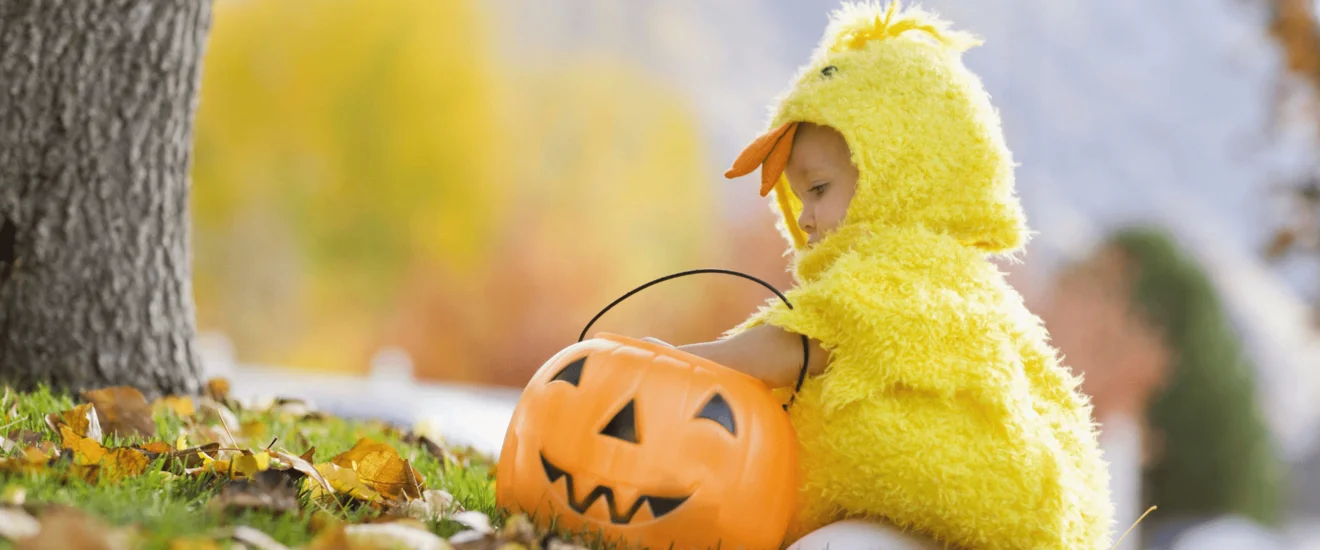Halloween is an exciting time of year filled with fun activities, exciting costumes, and lots of candy that many children and their families look forward to every year. However, for children with autism, Halloween can come with potential challenges. Loud and creepy noises, scary decorations, lots of strangers, and uncomfortable costumes, are just a few of the potential challenges children with autism spectrum disorder (ASD) may face on Halloween.
But that doesn’t mean your child with autism can’t enjoy Halloween. By being proactive and aware of your child’s needs you can have an autism-friendly Halloween that the entire family can enjoy.
Preparing for Halloween
Preparing your child for Halloween should start days or even weeks in advance. To help prepare your child for Halloween you can:
- Talk to your child about Halloween. Explain to them what happens on Halloween, how children dress up, and what trick-or-treating is. Remind them that the decorations and costumes are make-believe and just for fun.
- Use social stories. Social stories can help prepare your child for what their Halloween will look like. Many children with autism prefer routine and predictability which can be thrown off by special occasions like Halloween. A visual story outlining the new activities for the day can help them be prepared.
- Read books and watch movies, television shows, and YouTube videos about Halloween. Like social stories, books and videos can help give your child a better idea of what Halloween is like and what to expect.
- Count down the days with a calendar. Show your child when Halloween is on a calendar and mark off the calendar day by day. This can help your child prepare for Halloween in advance and better understand when the holiday is.
Sensory-Friendly Costumes
One of the best parts of Halloween is dressing up, but many traditional Halloween costumes are not very sensory-friendly. Halloween costumes are often made of tight uncomfortable fabrics or might include face masks.
But with just a little preparation and thinking outside the box you can help your child find their perfect sensory-friendly costume for Halloween.
Here are some tips, tricks, and ideas for choosing a sensory-friendly Halloween costume for your child with autism:
- Think about your child’s special interests when helping them select a costume.
- Consider costumes that can fit over their regular clothes like a cape or butterfly wings.
- Character hoodies are a great comfortable and warm choice for kids with autism. Pajamas, like a fun character onesie, are also fun, easy, and cozy costume options.
- Try turning regular clothes with a theme into a costume. Construction workers, period costumes like the 70s or 80s, or characters like Waldo from Where’s Waldo are all great costume ideas that can be created with regular clothes.
No matter which costume you choose, be sure to have your child try on the costume before Halloween arrives to make sure the costume fits right and is comfortable. Also, have them wear their costume several different times leading up to Halloween, so they can get used to how the costume feels and moves. If there is a problem, don’t force your child to wear a costume they don’t want to.
Halloween Decorations
A lot of Halloween decorations are meant to be scary, with lots of ghosts, witches, black cats, and bats everywhere. And many Halloween decoration setups also include bright flashing lights, loud sounds, and maybe even a fog machine.
These elements are meant to be fun, but they can easily be overwhelming for a child with autism.
Here are some ways you can help make Halloween decorations less challenging for your child:
- Remind your child that the decorations and sounds are just pretend. If you can, take your child around to see some of the homes in your neighborhood during the day.
- Be aware of and on the lookout for moving decorations, sounds, flashing lights, and fog machines. These can surprise and easily overwhelm your child.
- If trick-or-treating, take sensory toys for your child to use throughout the night. Bring headphones or earplugs in case loud noises become overwhelming.
- If necessary skip homes that you think may overwhelm your child and choose homes with more simple sensory-friendly decorations.
Trick-or-Treating
Not all children are interested in trick-or-treating, however, if your child wants to, here are some tips to help the night run smoothly:
- Walk your planned Halloween route before Halloween night. This will help your child get a better idea of what to expect and give you a better idea of any homes that may be too scary for a visit.
- If your neighbors are willing to help out, practice going to a neighbor’s door, ringing the doorbell, and receiving candy. If your neighbors are not available to help, you can easily practice trick-or-treating at your own home too.
- The night of Halloween, don’t push your child’s limit. They may only be able to go to one or two houses and that’s okay. Regularly check in with your child throughout the night to assess how they are feeling and take as many breaks as needed.
- Speaking of breaks, stay close to home. Your child will likely feel more comfortable in their own neighborhood and staying close to home will make it easier for them to take breaks at home throughout the night if necessary.
- Consider trick-or-treating at a community event where the child is comfortable and knows the people.
- Partner with family and friends that your child likes and is comfortable with to go trick-or-treating. Friendly familiar faces may help your child feel more comfortable and less overwhelmed.
- A common tradition on Halloween is for trick-or-treaters to say “trick-or-treat” when they come to a door, but if your child is non-verbal that is okay. Saying “trick-or-treat” is not a requirement. As a family decide the best way to disclose that your child is non-verbal and/or has autism. You can do this by using a button or a sign or even a bag that says something like “Non-Verbal Trick or Treater- Please be Patient.”
Other Halloween Activities
Your child may not want to go trick-or-treating on Halloween and that is okay too. There are many other ways they can enjoy this spooky holiday. As a family, you can all watch a family-friendly Halloween movie or try out some fun Halloween crafts.
Click here for sensory-friendly Halloween activity ideas!
Halloween Safety Tips
Halloween can be hectic and unpredictable and safety should be at the top of every parent’s mind. For parents with children with autism, it is important to remember that even in familiar environments new sights and sounds can increase the risk of wandering. Some ways to help keep your child safe on Halloween include:
- Taking their picture in their costume before they go trick-or-treating. This way if they do get lost you will have a recent picture of what they looked like and were wearing that night.
- Lighting your child up. If you are worried your child may wander, have them wear clothing that lights up, like light-up sneakers or glow stick bracelets and necklaces. Anything that will make them easier to spot in the dark.
- Making yourself easy to find. You may encounter crowds or large groups of people on Halloween and you want to make it easy for your child to spot you in the crowd in case you get separated.
- Make sure your child has identification on them and a way to communicate if they get lost. This can be as simple as writing your name and cell phone number on a piece of paper and placing it in your child’s pocket.
Trick-or-Treaters at Your Home
Whether your child decides they don’t want to go trick-or-treating, or you simply get home earlier in the night, if you plan on receiving trick-or-treaters at your home here are some things you can do to help your child prepare:
- Practice greeting people at your door and giving out candy.
- If you’re worried things may get too busy or become overwhelming, remember you can always leave a bowl of treats outside your door with a note not to knock or ring the doorbell.
- Wrap up the night whenever you are ready. Even though Halloween can be a late-night event, your family can end it whenever you want. Turn off your porch light and lock your doors when your family has had enough for the night.
Have a safe and spooky Halloween!






